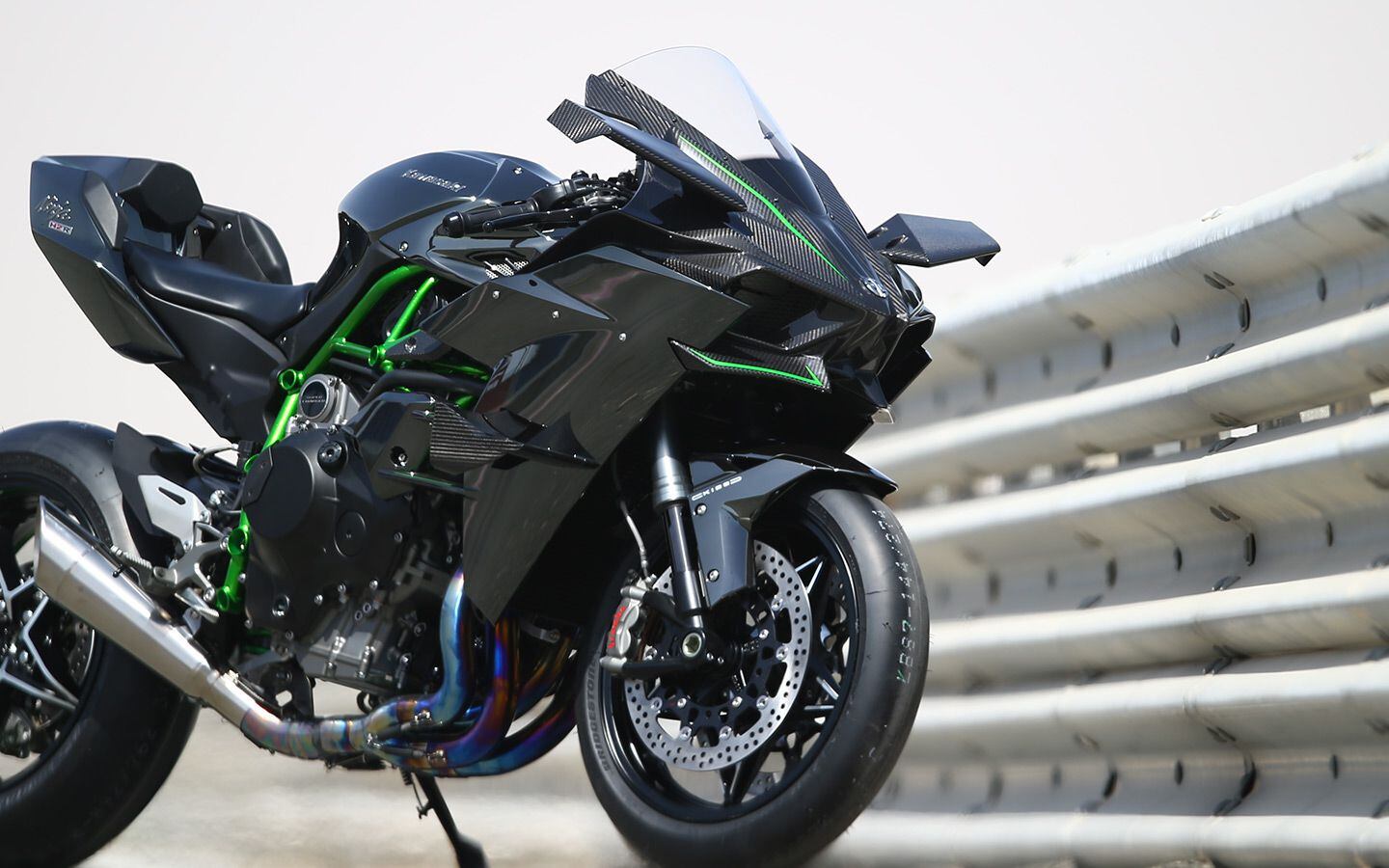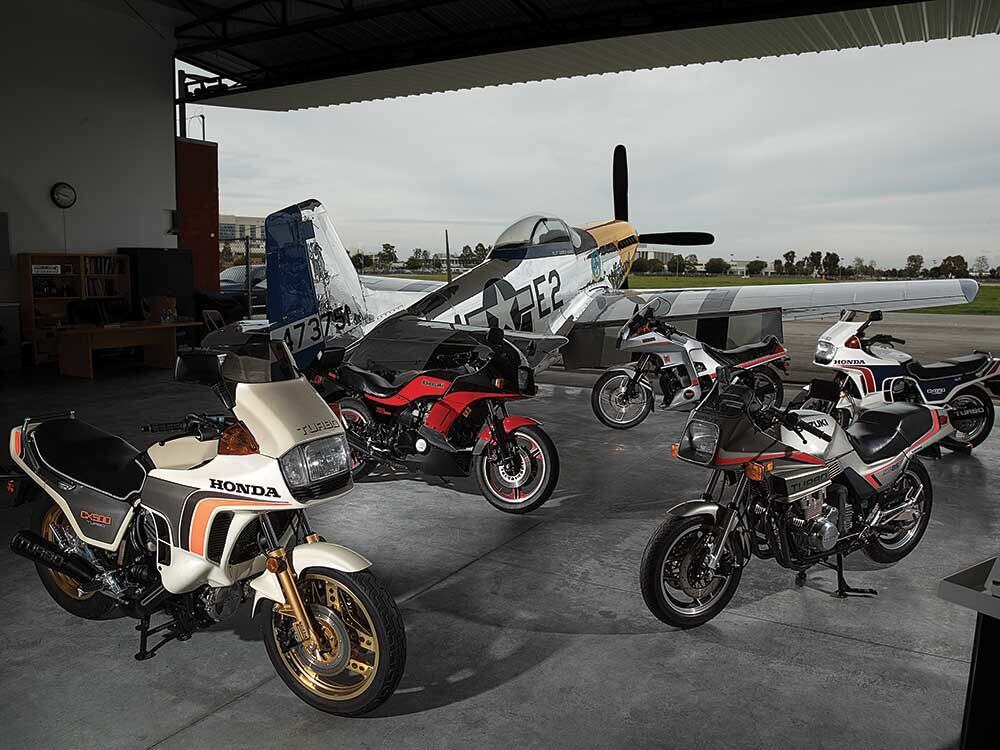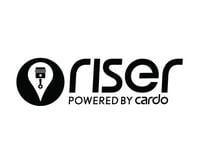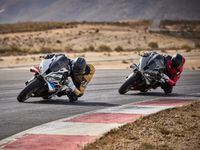Kawasaki shocked the world three years ago when it unveiled the supercharged H2 and H2R sportbikes. The 16-valve, DOHC, 998cc inline-four that powers both of those hot rods is boosted by a mechanically driven centrifugal supercharger to generate in track-only H2R trim 310 hp at 14,000 rpm and 115 pound-feet of peak torque at 12,500 rpm.
The engineering team had one obvious target: Give life to the most powerful production motorcycle in the history of the sport, whatever use that would be good for in real life. Large displacement, oversquare bore and stroke (76 x 55mm) for sky-high revs, plus supercharging—no prisoners taken.
While the H2/H2R is a clear statement of technological leadership, neither supercharging nor turbocharging has so far done for the motorcycle what it has done for 20 years for production automobiles: Allow a small engine to deliver high fuel economy at freeway speeds, yet with forced induction to also deliver spirited acceleration and real-world on-ramp performance.
The problem that has kept this from happening on two wheels is the limited tire footprint of the motorcycle. Not only does a motorcycle have only two wheels, but it uses only one-third of the width of those two tires. This small footprint cannot transmit the fast-rising and peaky torque of either turbocharging or the centrifugal supercharger of the Kawasaki H2/H2R.
A motorcycle’s drive wheel requires extremely smooth, predictable torque, which is why modern engine-control electronics (ride by wire, virtual powerband, traction control, anti-wheelie) have had such good success in smoothing the power delivery of existing bikes.
In revealing its “Balanced Supercharging” concept in 2015, Kawasaki showed a rotary shutter in the intake of a centrifugal blower (possibly similar to the “vortex throttle” used on Cosworth Champ Car engines) but did not explain either its purpose or function. We can only speculate that it might be used with fast computer control to maintain a desired boost pressure in an engine’s sealed intake airbox, thereby dealing with the old problem of torque that rises too fast for human control.
We will have to wait to see what Kawasaki reveals at EICMA this November. In a teaser about "Balanced Supercharging," Kawasaki refers to a new generation of sport-tourers equipped with supercharged engines that were conceived to deliver supreme flexibility and great torque at relatively low rpm.
Ford did something similar with its 1.0-liter three-cylinder EcoBoost engine, a little turbocharged monster that became the new standard in spark-ignited engineering for its solid peak power—140 hp at 6,000 rpm, combined with an incredibly thick and flat torque curve (133 pound-feet of torque at a mere 1,500 rpm)—and very low fuel consumption.
Ford applied lessons learned from diesel engine practice: a nearly flat pent-roof cylinder head (modest 22 degrees included valve angle) with the largest portion of the combustion chamber a deep bowl in the piston crown. This configuration proved effective at reducing knock despite compression exceeding 10:1, high for a mass-production supercharged engine.
In addition, the deep chamber keeps tumble turbulence alive through the compression/combustion cycle for perfect combustion and high efficiency. The combination proved to be a shortcut to high efficiency and torque not seen since the days of the Ford-Cosworth DFV 3.0-liter Formula 1 V-8, the engine that in 1967 set new thermodynamic standards.
Ford used turbocharging to reset the relationship between displacement, revs, and mean effective pressure, the main factors that participate in the definition of the power generated by internal-combustion piston engines. In this case, engineers drastically reduced the influence of revs and boosted mean effective pressure to an extremely high 304.5 psi. For a street-legal, naturally aspirated engine, we would be happy to see slightly more than half of that, say, 174 psi.
Not having to worry about mean piston speed, Ford engineers selected a small bore and a long stroke, which contributed to the clean, efficient, high-compression-ratio combustion chamber. Kawasaki appears to have adopted that same philosophy to deliver supremely flexible engines combining additional torque delivery, smoothness, and power.
Kawasaki used a mechanically driven supercharger for the H2/H2R. Can we in the future expect an electrically driven supercharger managed by the ECU for even higher engine efficiency and smoothness? Audi has done this with its SQ7 turbodiesel 4.0-liter V-8, and it works well.
If Kawasaki is able to combine small-engine economy with big-engine torque and power through a new and more controllable form of supercharging, that company will have opened a previously closed door to the future.












/cloudfront-us-east-1.images.arcpublishing.com/octane/JJ3MC6GNDFF5ZNYD3KD3E4EY7Y.jpg)
/cloudfront-us-east-1.images.arcpublishing.com/octane/XH2ETEU4NVGDFNQO2XT2QQS5LU.jpg)
/cloudfront-us-east-1.images.arcpublishing.com/octane/UFG652C27BDBFPK42TDAJ5CMX4.jpg)
/cloudfront-us-east-1.images.arcpublishing.com/octane/AUE3NFVRRZDSBIDVUGIYIDQNUI.jpg)
/cloudfront-us-east-1.images.arcpublishing.com/octane/LYR62CH2WNBMHJJVXVATZHOUE4.jpg)
/cloudfront-us-east-1.images.arcpublishing.com/octane/RBCTRGBQYBDK7A6XPG3HKPS7ZQ.jpg)
/cloudfront-us-east-1.images.arcpublishing.com/octane/MQXQRYMZVBCWJIRYP3HEN3SHVE.jpg)
/cloudfront-us-east-1.images.arcpublishing.com/octane/TSPODNNEWRDSVJGUCNQTDG4ADI.jpg)
/cloudfront-us-east-1.images.arcpublishing.com/octane/X5TB7BDV4BA2RPSY54ZGK27RP4.jpg)
/cloudfront-us-east-1.images.arcpublishing.com/octane/REUHOJXRDBGZ5IHBYZCCBCISPA.jpg)
/cloudfront-us-east-1.images.arcpublishing.com/octane/52LGJTCKBFEHDF7S7H4CVUIMGM.jpg)
/cloudfront-us-east-1.images.arcpublishing.com/octane/YMWAIPIPSJAOXOU3QMJMGH37OM.jpg)


/cloudfront-us-east-1.images.arcpublishing.com/octane/EJ6KZRGAYBCVXNL2PJXL37UVWQ.jpg)
/cloudfront-us-east-1.images.arcpublishing.com/octane/AAN4TI76M5H5JMUVEIGASWXBDU.jpg)
/cloudfront-us-east-1.images.arcpublishing.com/octane/P3RXD2UCPFF37CMB7CHPVKXORY.jpg)
/cloudfront-us-east-1.images.arcpublishing.com/octane/VZEG2EJI2RDFZNHLRZMU56MD3Q.jpg)
/cloudfront-us-east-1.images.arcpublishing.com/octane/GVJQO5FFOFBWNGODOBRB4FBAW4.jpg)
/cloudfront-us-east-1.images.arcpublishing.com/octane/BIVAK2SFIBDJJM25E7I5VU2FJE.jpg)
/cloudfront-us-east-1.images.arcpublishing.com/octane/CH5VX52UG5CFHOVH5A6UYEFWWA.jpg)
/cloudfront-us-east-1.images.arcpublishing.com/octane/ZVGJNGZRU5C33N7KN23BBFKSC4.jpg)

